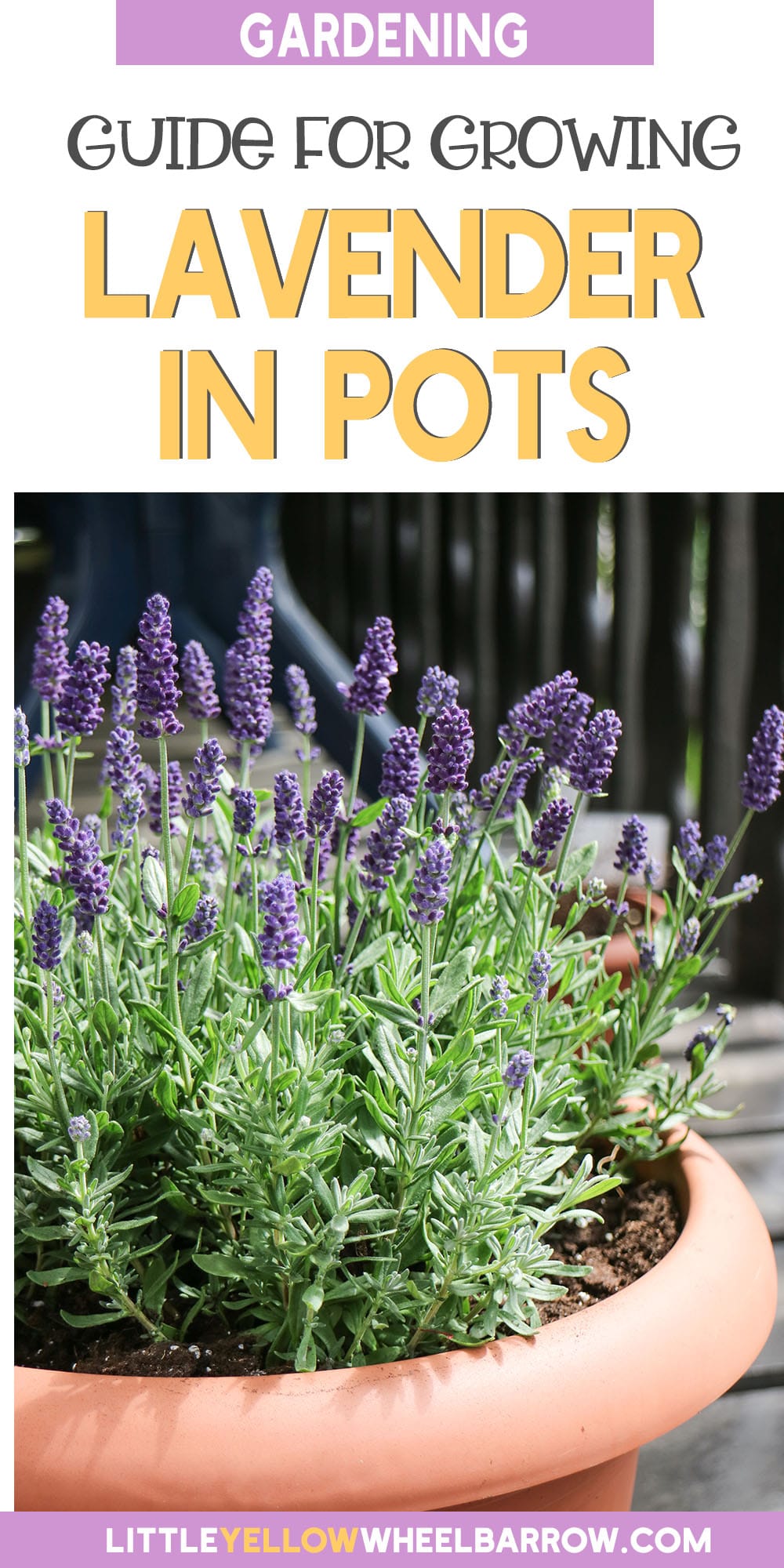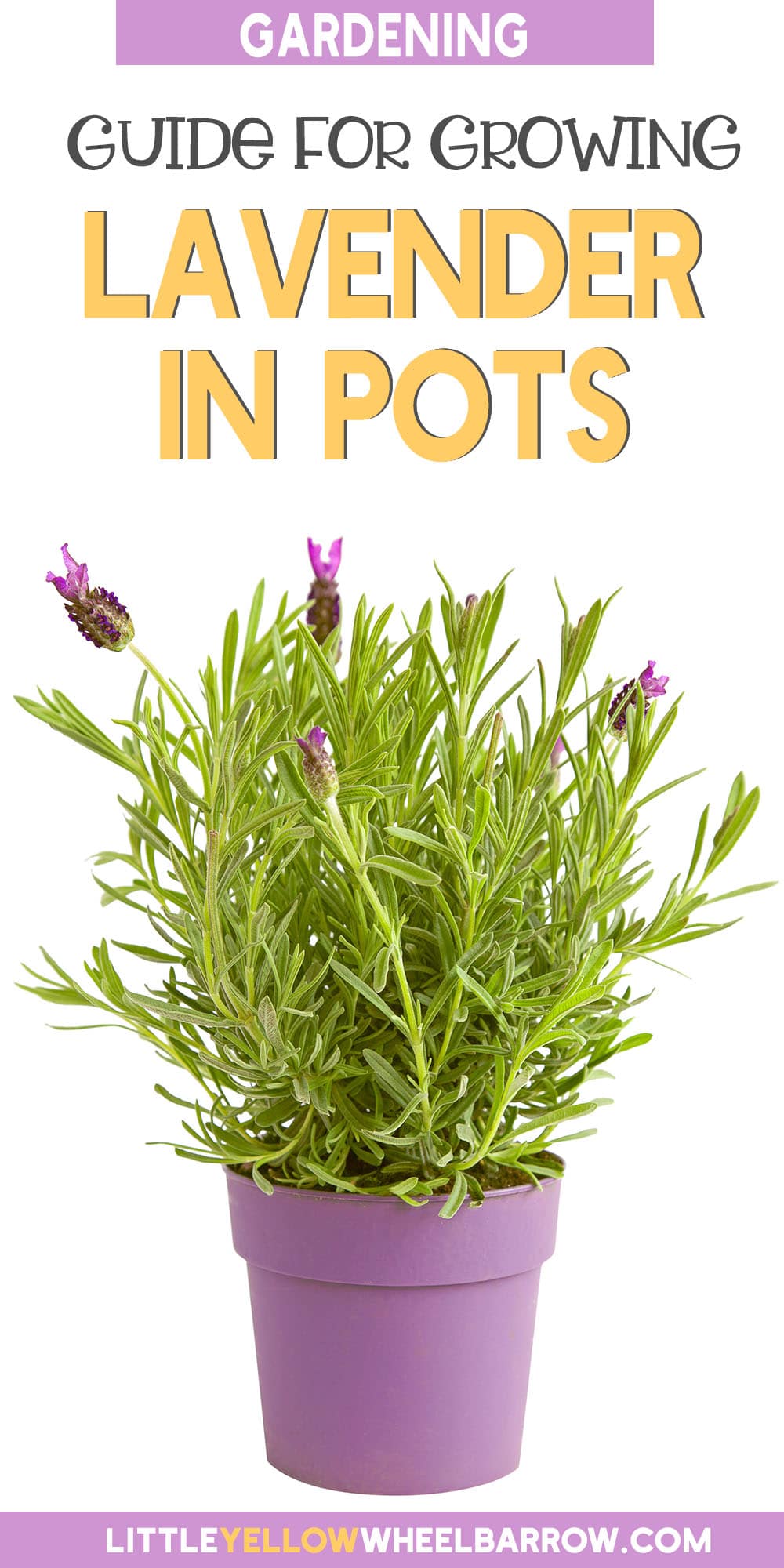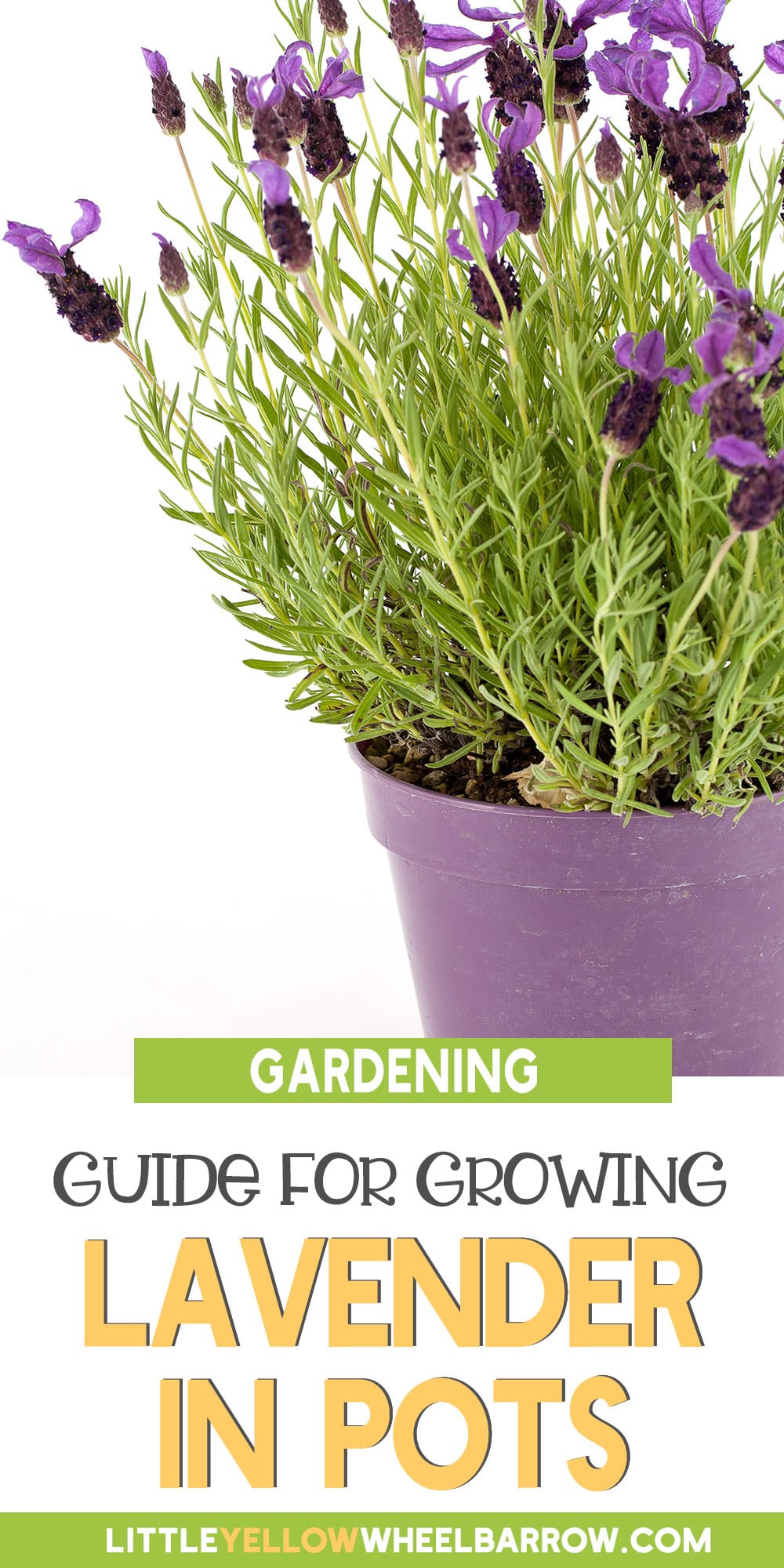Growing Lavender in Pots Year Round – The tips You need!
Growing lavender in pots is a great way to add color and fragrance to your home. The plants can be grown indoors, in containers, or even in hanging baskets. This blog post will walk you through the steps you need to know to grow beautiful full containers of lavender that you can enjoy year-round. To grow lavender in pots takes a bit of know-how to get it right, but we have you covered with all the tips you need.
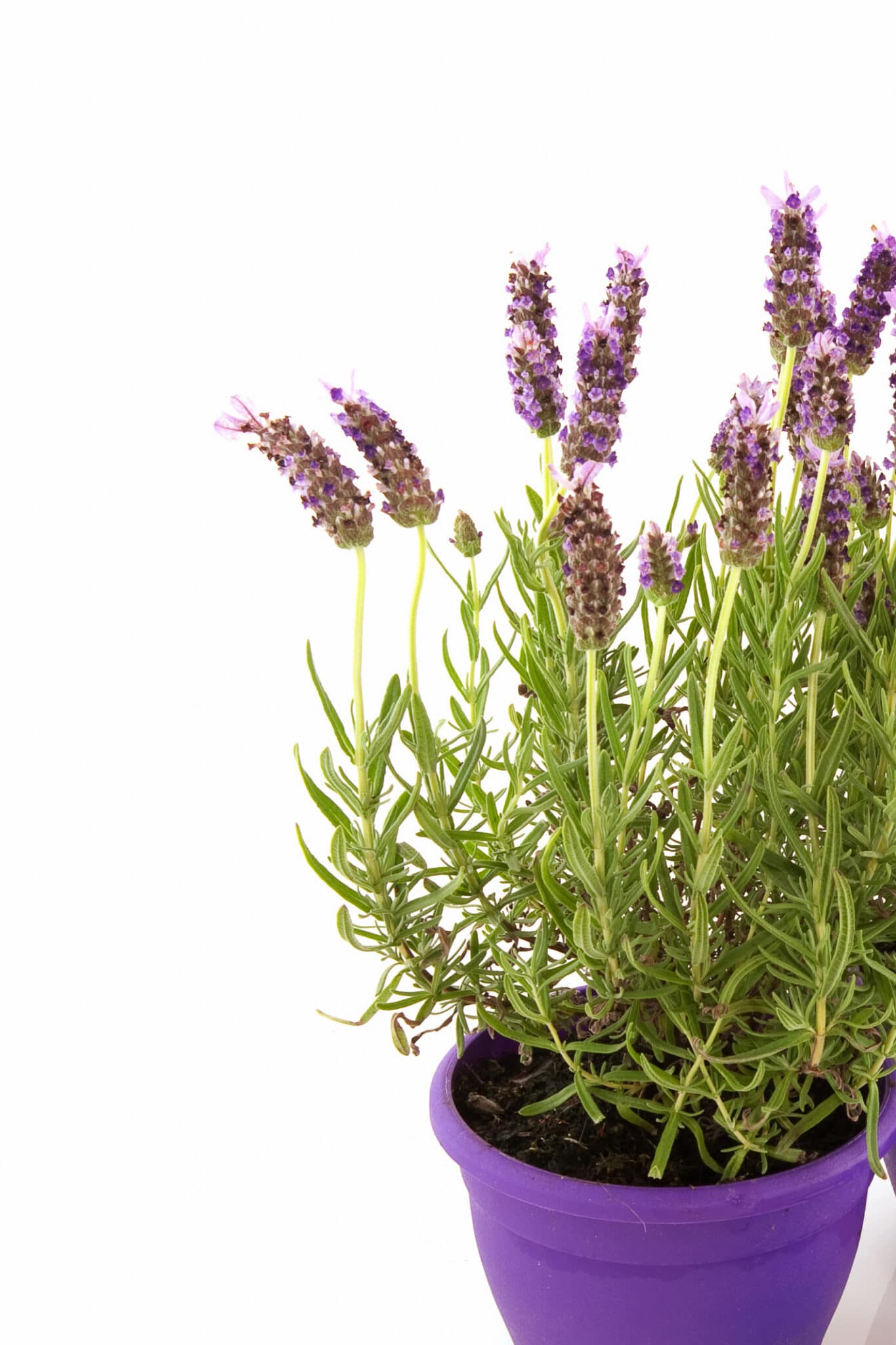
Lavender is a widely grown garden plant that offers various benefits. Its pleasing fragrance can help alleviate stress and promote better sleep. Additionally, when placed outdoors, it attracts pollinators like bees and butterflies. Potted lavender can also make a long-lasting addition to your space, provided it receives proper care, such as enough sunlight, correct watering, and regular pruning. In this article, we will share our top tips on how to grow lavender in containers so you can create beautiful and healthy displays.
Step 1: Start with The Right Size Pot or Container
Looking for pots larger than 12 inches for a showy display would be best, but you do not need deep pots. For example, 6-8 inches deep is adequate for lavender’s short root system. You only need one lavender plant per 1 square foot of potting space.
Terracotta pots make excellent containers for planting lavender. The pots help wick away excess moisture and give the plant a sturdy growing vessel.

Step 2: Be Sure to Use Good, Well-Draining Potting Soil
For containers, use about six inches deep of good quality garden soil. Potted lavender plants prefer slightly alkaline soil pH levels.
Note: It’s a good rule of thumb not to pack down your soil too hard when planting because it can cause problems later. Potted lavender plants can become “root bound,” stunting growth and stressing the plant. Stressed plants succumb to diseases and pests far more than healthy plants.
Any well-draining type of soil is suitable for planting lavender flowers.
One great choice for soil is a cactus or succulent mix, typically containing sand, peat moss, organic matter, and perlite. These three ingredients are necessary because they provide different benefits, making them perfect for growing outdoor and indoor lavender plants.
Step 3: Gather your Gloves, Spade, Trowel, and Plant Markers
In addition to choosing your soil, you’ll also want some garden stakes or stones (to weigh down the pots) and plenty of good quality compost so you can start fertilizing from day one!
You may even consider adding in a few slow-release organic fertilizer pellets. Here are a few extras you may want to consider:
- Garden gloves
- Spade
- Trowel
- Plant Markers
Or check out our post on all the must-have gardening tools!

Step 4: Choose Lavender Varieties that Grow Well in Containers
Some of the most popular varieties of lavender for pots are:
- English Lavender (lavandula angustifolia)
- Grosso lavender
- Provence (also called French lavender) – this is the best lavender for scent.
- Spanish lavender (Lavandula stoechas)
Every type of lavender has its characteristics and benefits, but they’re all great plants to grow in containers.
The best way is to choose based on color preference. For example, if you like purple flowers, the “Grosso” variety is a good choice because it’s a deep lilac shade with lovely green foliage. On the other hand, if you want something more blueish or greenish, get an “English Lavender.” And some people love the scent of Provence lavender. Many fragrant varieties exist, but these three types are the most popular for containers.
You can also plant lavender around your vegetable and herb garden to add a bit of color and help attract pollinators.
Step 5: Start your Lavender Seeds Indoors 4-6 Weeks Before the Last Frost
Knowing when to plant lavender is crucial for its successful growth. It is recommended to start lavender 4-6 weeks before the last frost date in your area. This timing allows the plant to establish its roots before the growing season begins in earnest.
To start lavender from the seed, you need the freshest seeds possible. You can find them at your local nursery or on a reputable website like Amazon.
Prepare your seeds in early spring. First, fill your seed tray or small pots with potting soil, then sow the seeds on the top. Next, gently press them into the ground and sprinkle them with the potting mixture.
- Lavender seedlings require lots of light to germinate, so use a sunny window or grow lights.
- Water the seeds daily and keep them moist at all times, but don’t overwater!
- Wait about four weeks before planting outside or moving on to your containers.
You will seed new growth for your lavender seedlings in about 12-20 days from planting the seeds.
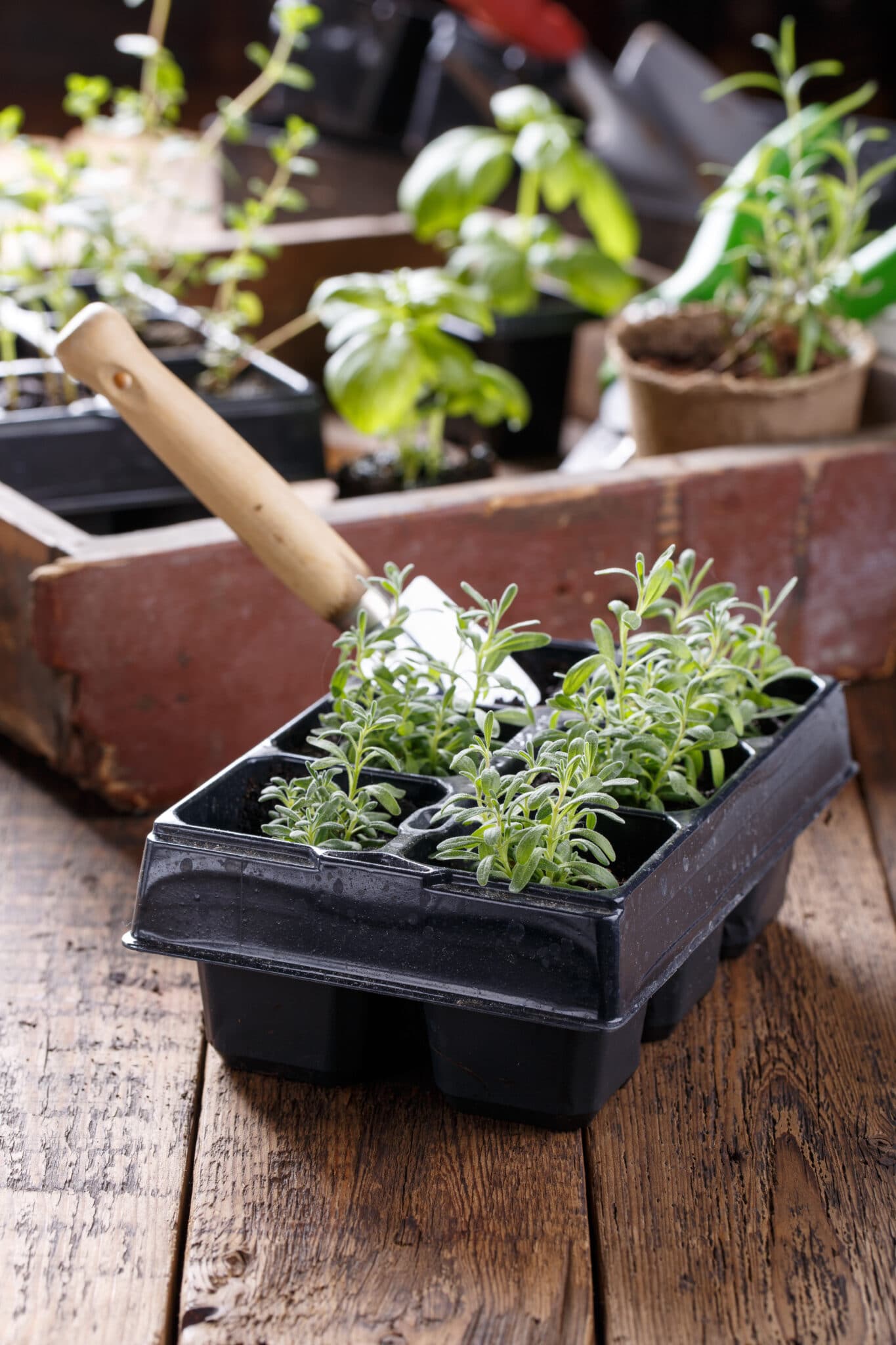
Step 6: (or) Propagate Established Plants by Taking Cuttings
You need a few inches of soft stem to take cuttings from your lavender plant. Cut the stems below where they meet the bottom leaves and place them in a water-filled container or jar.
Put the lid on loosely so that some air can escape without letting bugs enter it.
Keep these slips watered regularly until they start sprouting roots. Once the cuttings have grown roots at least 2 inches long, plant them in your containers. Remember, each potted lavender plant will require a minimum of 1 square foot of space to ensure good air circulation.
Once established in its new potting mix, keep well watered and fertilized as needed.

Step 7: Provide Your Lavender Pots with at Least 8-10 Hours of Direct Sunlight
Potted lavender will require full sun, so place the container where sunlight will be abundant.
It’s best to place indoor lavender plants in the sunniest southern-facing window or under a grow light.
For outdoors, be sure to add them to any spaces in your yard that receive at least 8-10 hours of sun.
Step 8: Water Your Lavender Plants Every 2-3 Weeks in Hot Weather
Overwatering is one of the leading causes of failure when growing lavender! So it’s best if you check the soil moisture regularly.
The key to watering your plants is moderation: make sure they don’t get too dry or overwatered (you’ll know when it’s time to water again because roots will come out of the drainage holes in the bottom!) The general rule of thumb is once every two weeks.
Yellowing leaves can be a sign of overwatering.
Excess water should easily flow out the bottom of your containers.
Step 9: Address Diseases and Pests as Soon as Possible
Lavender can be attacked by a fungal infection like leaf spot, bacterial rot, crown rot, and root rot. As well as bacterial diseases like wilt and fusarium. The best method of dealing with these diseases is prevention. Please ensure the container where you plant your lavender is well-draining; do not overwater, and keep the top of the soil dry by covering it in pebbles or mulch.
Aphids, root knot nematodes, thrips, and whiteflies can all be a challenge when growing lavender, so be sure to deal with pests immediately. Most problems that attack lavender can be controlled with insecticidal soap or by planting a few lavender companion plants like marigolds nearby.
Controlling diseases and pests immediately will help you grow healthy, productive plants.

Step 10: Don’t Forget to Harvest Your Lavender Flowers
Harvest lavender flowers in late summer with clean gardening shears or sharp, sanitized scissors. It will help to cut the stem close to the bottom of the lowest branch.
Make sure to cut at least an inch off the soil’s top. This cutting method helps prevent bugs and mold from getting on your lavender plant.
You can strip away the lavender buds and use them fresh in baking (so long as you used no pesticides during their growth cycle).
You can also dry your lavender in potpourri, displays, and fragrance bags or in the kitchen. In addition, lavender makes a beautiful cut flower for vases.
Learn More: I often dry my lavender in my dehydrator; you can tie a bundle and hang it upside down in a dry, warm spot. We have an entire guide to teach you how to dry lavender that you should bookmark for when it’s time to harvest your lavender.
Step 11:Take Care of your Container Grown Lavender in Cold Winters
Bring your container-grown lavender indoors in cold climates when winter has a hard freeze. In milder climates, mulch the top of the soil well and place the containers in a sheltered location.
Protecting your lavender plants over winter will ensure your pots are long-lasting. For more information, check out our full guide to winterizing lavender.
Some interesting facts about lavender:
- Lavender essential oils were used as a scent for perfume in ancient Rome.
- It is the most popular essential oil and can be found at many grocery stores.
- The smell of lavender is relaxing, and studies have shown it mildly effective for insomnia and anxiety.
- There are over 20 types of lavender!
- Lavender is an edible perennial herb. It’s delicious and used in baking for custards, cookies, and even cakes! Lavender is popular in dishes from France.
- Lavender is one of the most used scents in bath and body products. From bath products to soap, it’s the fragrance you can most easily find.

Expert Tips
Growing lavender in pots can be very rewarding with the right care. Here are some expert tips to help you succeed:
- Choose the Right Pot: Select a pot at least 12 inches in diameter with drainage holes to prevent waterlogging.
- Use Well-Draining Soil: Lavender thrives in well-draining, slightly alkaline soil. Mix in some sand or gravel to improve drainage.
- Pick the Right Spot: Place your pot in a location that receives at least 6 to 8 hours of direct sunlight daily.
- Water Sparingly: Lavender prefers dry conditions. Water only when the soil is dry to the touch, and avoid letting the plant sit in water.
- Fertilize Lightly: Use a slow-release, low-nitrogen fertilizer once at the beginning of the growing season.
- Prune Regularly: Trim back lavender after it blooms to encourage bushy growth and prevent it from becoming leggy.
- Winter Care: In colder climates, move pots indoors or to a sheltered area to protect them from freezing temperatures.
- Repot as Needed: Lavender plants can outgrow their pots. Repot every few years or when you see roots from the drainage holes.
Following these simple tips, you can enjoy the beautiful blooms and aromatic fragrances of lavender right from your porch or balcony.
FAQ
To care for lavender plants in pots water them only when the soil is dry, ensure they get 6-8 hours of sunlight daily, use well-draining soil, and prune after flowering to encourage growth.
Use a slow-release, low-nitrogen fertilizer once at the beginning of the growing season to feed your lavender.
Plant lavender with companions that enjoy similar growing conditions, such as rosemary, thyme, oregano, and marigolds.
Yes, you can grow lavender in pots outside, provided they are placed in a sunny spot and the pots have good drainage.
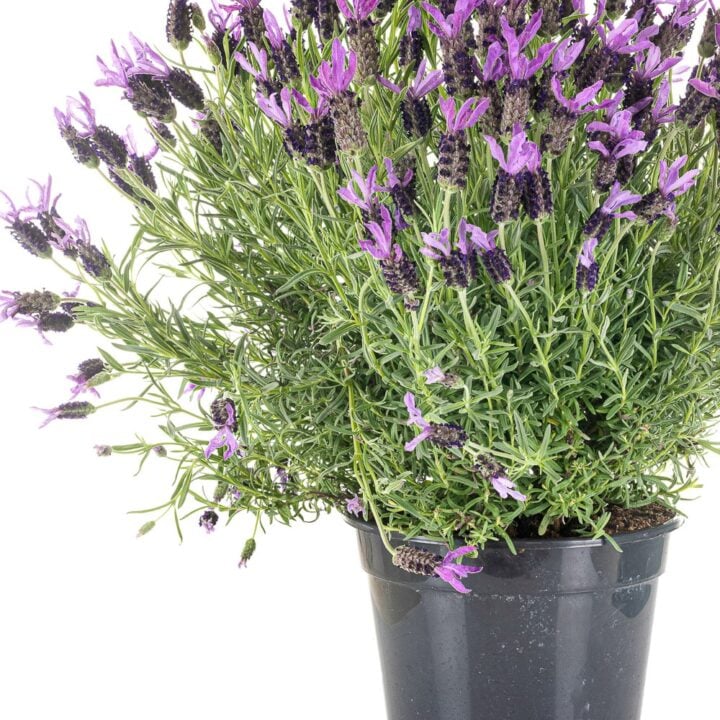
Instruction Card: Growing Lavender in Pots
The step by step process of growing healthy lavender plants in pots in containers.
Materials
- Lavender seeds
- 12 inch pots with drainage
- Good, organic rich soil
- Watering can
- Fertilizer
Tools
- Gloves
- Trowel
- Indoor grow lights (optional)
Instructions
- Step 1: Start with The Right Size Pot or Container
- Step 2: Be Sure to Use Good, Well-draining Potting Soil
- Step 3: Gather your Gloves, Spade, Trowel, and Plant Markers
- Step 4: Choose Lavender Varieties that Grow Well in Containers
- Step 5: Start your Lavender Seeds Indoors 4-6 Weeks Before the Last Frost
- Step 6: (or) Propagate Established Plants by Taking Cuttings.
- Step 7: Provide Your Lavender Pots with at Least 8-10 Hours of Direct Sunlight
- Step 8: Water Your Lavender Plants Every 2-3 Weeks in Hot Weather.
- Step 9: Address Diseases and Pests as soon as possible.
- Step 10: Don't Forget to Harvest Your Lavender Flowers
- Step 11:Take Care of your Container Grown Lavender in Cold Winters
Notes
- Choose the Right Pot: Select a pot at least 12 inches in diameter with drainage holes to prevent waterlogging.
- Use Well-Draining Soil: Lavender thrives in well-draining, slightly alkaline soil. Mix in some sand or gravel to improve drainage.
- Pick the Right Spot: Place your pot in a location that receives at least 6 to 8 hours of direct sunlight daily.
- Water Sparingly: Lavender prefers dry conditions. Water only when the soil is dry to the touch, and avoid letting the plant sit in water.
- Fertilize Lightly: Use a slow-release, low-nitrogen fertilizer once at the beginning of the growing season.
- Prune Regularly: Trim back lavender after it blooms to encourage bushy growth and prevent it from becoming leggy.
- Winter Care: In colder climates, move pots indoors or to a sheltered area to protect them from freezing temperatures.
- Repot as Needed: Lavender plants can outgrow their pots. Repot every few years or when you see roots from the drainage holes.
Grab Our Ultimate PRINTABLE Garden Planner
With 39 pages of planning and organizing and the ability to customize your planner with the pages you need, you won’t need another planner for the rest of your gardening life!
$4.99 US

Final Remarks
Growing lavender in pots may seem challenging, but it’s easier than you think with these easy steps. If you follow these instructions, there will be no need for fear when growing lavender. Be sure to give yourself time to enjoy this excellent plant and all its wonderful uses.
Related Posts

Author: Laura Kennedy
Writer & Owner of Little Yellow Wheelbarrow
Editor’s Note: This post was originally published on March 19, 2022. It was updated on February 15, 2024 to include an FAQ and Expert Tips.

